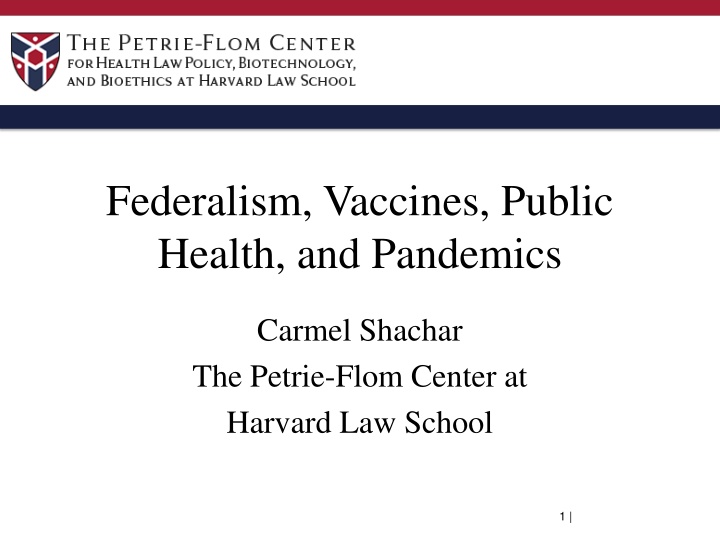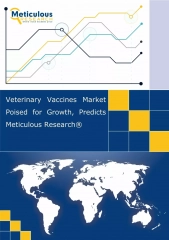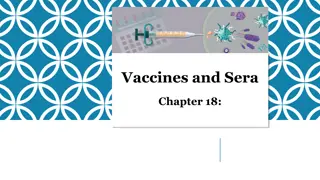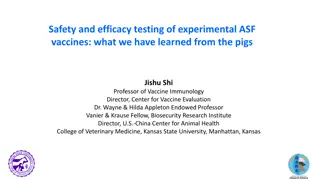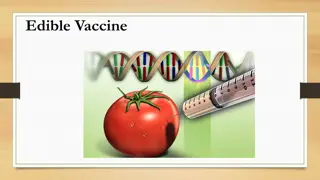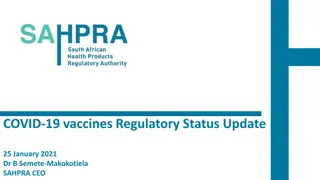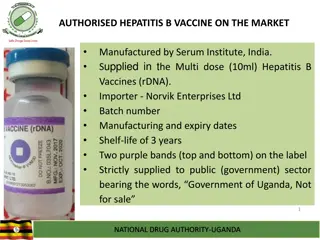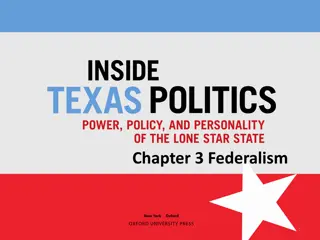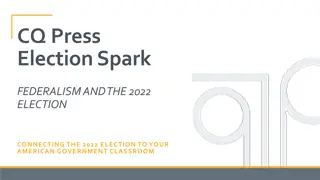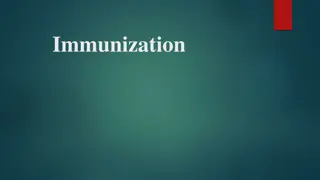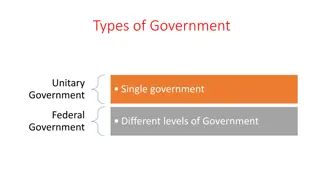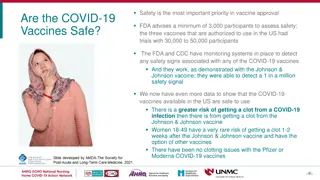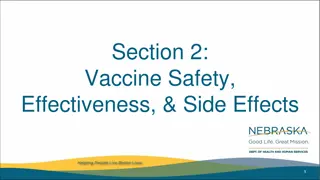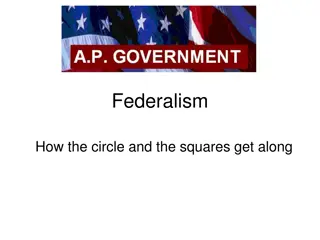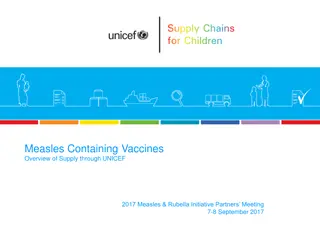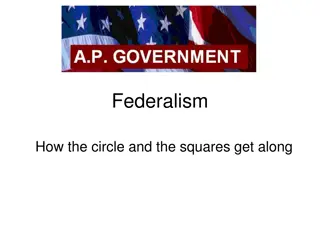Federalism, Vaccines, and Public Health
Intersection of federalism, vaccines, and public health through the historical context of Jacobson v. MA (1905) and the evolving role of the federal government in health care. Learn about traditional public health federalism, COVID-19 implications, vaccine allocation strategies, and the impact of federalism on public health policies.
Download Presentation

Please find below an Image/Link to download the presentation.
The content on the website is provided AS IS for your information and personal use only. It may not be sold, licensed, or shared on other websites without obtaining consent from the author.If you encounter any issues during the download, it is possible that the publisher has removed the file from their server.
You are allowed to download the files provided on this website for personal or commercial use, subject to the condition that they are used lawfully. All files are the property of their respective owners.
The content on the website is provided AS IS for your information and personal use only. It may not be sold, licensed, or shared on other websites without obtaining consent from the author.
E N D
Presentation Transcript
Federalism, Vaccines, Public Health, and Pandemics Carmel Shachar The Petrie-Flom Center at Harvard Law School 1 |
Roadmap Traditional public health federalism The expansion of the federal government s role in public health COVID-19 and federalism Vaccine allocation Employment based testing and vaccines Where next? 2
Federalism and Public Health 101 What would we learn in a session of public health law? Federalism government is traditionally limited in its role in public health States are expected to take the lead as they have police power Police power was considered VERY broad, perhaps even beyond the reach of constitutional law Classic example: school vaccinations, which are largely state led Applied to pandemics: The federal govt took the lead in regulating smallpox vaccination in the Vaccine Act of 1813 but then repealed it in 1822, leaving states to take the lead. 3
Federalism and Public Health 101 Jacobson v. MA (1905): Considered the classic public health case BUT IT IS OLD (pre Blue Cross, pre rise of health care industry) Jacobson is used to defend police power exercises Post-Jacobsoncourts affirmed states authority to (1) regulate individuals and businesses for public health and safety (8 cases), (2) limit liberty to achieve common goods (34 cases), (3) permit legislatures to delegate broad powers to public health agencies (5 cases), and (4) defer to the judgment of legislatures and agencies in the exercise of their powers (13 cases). But Jacobson also established some standards to safeguard individual interests (necessity, reasonable means, proportionality, harm avoidance) In contrast to Lochner v. NY (1905) that struck down a state regulation limiting hours bakers could work as a violation of the due process clause of the 14th amendment Here is where we might have ended our class discussion of public health and federalism. 4
What happened since 1905? A lot in both federalism and health care! Won t go too deeply into changes in federalism as others at the conference can do it better than I can In health care the federal government took more and more active a role Food and drug regulations (FDA) Public health services act (establishing federal quarantine powers) Medicare and Medicaid Medicaid reflects our federalist structure while Medicare does not, Arizona did not have Medicaid for 18 years Medicaid waivers: executive federalism let states do what they want but only with federal guidance and approval 5
What happened since 1905? At the same time, local municipalities took ownership of public health In 1911 no county level public health departments and only a few in big cities By 2000, more than 3,000 local health units Creates a network able to deal with pandemics (contact tracing as an example) This trend has been somewhat reversed by states absorbing local departments of public health 6
ACA and Federalism The ACA is a statute that both uses federalism as a tool to achieve its goals and is limited by federalism Federal govt provided: protections for preexisting conditions, financial assistance for people with certain levels of income, and individual and employer mandates States were asked to: oversee insurance markets, run their own marketplaces, define essential health benefits, manage Medicaid expansion As the federal government takes on an ever-greater role in organizing and regulating the American health care system, it generally does so in partnership with the states, and the partnership at different times advances or hinders the prospect of policy success. 7
ACA and Federalism Medicaid expansion demonstrates the tension between public health goals and federalism NFIB v. Sebelius: SCOTUS made participation in Medicaid expansion optional under the spending clause (very unexpected) 37 states as of now have adopted expansion but through very different paths Expression of partisan federalism? Ballot box expansion in states such as Maine and Utah have been particularly interesting to watch Leads to sub-optimal public health outcomes? In 2020 2 million Americans do not have health insurance coverage 8
Federalism and COVID COVID has triggered significant federalism flashpoints between the federal govt and the states Procurement of PPE: states and fed were in competition, complaints of inadequate support State quarantine decisions: can t really shut down interstate travel Ex: HHS sent letter critiquing NV s decision to mandate that long term care facilities in the state stop using two COVID tests supplied by the fed govt, threatened with swift action Next point of tension will be vaccine allocation and requirements 9
What tools has Federalism given us to combat pandemics? Federalism can help set a floor on public health initiatives Allows some states to take things further (ex: shutting down businesses in hardest hit states in the spring) Federalism can help guide the decision to the appropriate decision makers Quarantine decisions best made at the state or local level (ex: Salem shutting everything down) Federalism can allow like minded states to work together Multistate collaborations in Mid-Atlantic, West Coast, Midwestern states Federalism is an Asset: Safra Center Distributed structures are of critical importance for resilience A state-led and tribally or locally administered approach to a national testing, contact tracing, and supported isolation program (TTSI) will make for easier integration with existing equal protection and civil liberties safeguards and allow more local control, empowerment, and participation in ways that can actually advantage minorities and allow for widespread citizen engagement. This is critical at a time of widespread feelings of helplessness. 10
What challenges does Federalism present to public health? Federalism can miss the point with infectious diseases Outbreaks do not respect state lines MA does fairly well, but MA citizens are precluded from traveling to Europe same as citizens from other states struggling with COVID Federalism can place entities at odd with each other Cities and states sparring over level of restrictions and who decides States competing for scare resources Federalism can undermine policy objectives that require high levels of cooperation, especially in eras of high tension Public health at heart is about organized social cooperation 11
Vaccination Efforts Vaccination is primed to become another public health flashpoint in 2021 Will COVID vaccinations be mandatory? If so, will they mandatory consistently across states? What sort of vaccine allocation plans are ethical or fair? 12
Vaccination Efforts Will COVID vaccinations be mandatory? We do require children and certain workers to obtain vaccines Would be unprecedented to require all adults to vaccinate Outdated constitutional law does not help provide clarity Have to consider the reaction to a heavy handed mandate 13
Vaccination Efforts Phase 1 2 Priority Group Health care workers (5%) People with pre-existing conditions at severe risk, seniors in densely populated areas (10%) Essential service workers at high risk, teachers/school staff, people in homeless shelters and prisons, people with pre-existing conditions at moderate risk, all other seniors (30-35%) Young adults, children, other essential workers (40-45%) Everyone else (5-15%) Assuming there are not enough doses for everyone, what sort of vaccine allocation plans are ethical and fair? 3 Does it matter if these are national, state, or local plans? 4 5 14
Employer Based Testing and Vaccinations Employers have a lot of incentives to require testing, antibody testing, and eventually vaccinations. Employment law places a high premium on confidentiality. If a positive case is identified in the workplace, the employer is encouraged to investigate the exposure of others in the workplace without disclosing the name of the individual or any personally identifiable information about the person. Some employers are allowed or required to ensure that their employees receive certain vaccinations 15
Employer Based Testing and Vaccinations Interesting because of the number of parties involved: Traditional: government and individuals Here: government, employers, and individuals Do we want the government or employers to take the lead on setting testing and vaccination policies? 16
What Next? In order to effectively address the current and future pandemics, we need to: Revisit and modernize Jacobson Understand how to bridge state-federal tensions more effectively Embrace that public health is very much a federal concern these days Develop plans to avoid patchwork responses to pandemics Perhaps using spending power to condition aid on compliance with pandemic response measures 17
